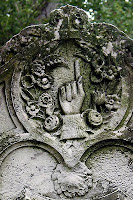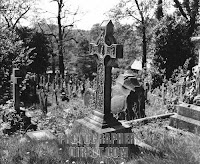
Temple or gravestone rubbing is believed to have originated with the Chinese, around 30 0 B.C. Originally, it was used as a method of communicating governmental decrees, a forerunner to the printing press. The government’s laws and messages were carved in stone then transformed to parchment by rubbing with colored wax or other permanent dye material. More recently gravestone and momument rubbings were once very popular, and a common field trip activity for schoolchildren. For me they are just really, really cool to frame and put in your living room, especially for Halloween. There are much more complex methods for achieveing a proper gravestone rubbing, but this one makes a great image and easy to do.
Things You'll Need:
• Conte crayon, or pastel
• Drawing Pencils
• Pencil Sharpeners
• Tracing Paper
• Crayons
• Masking or Painters Tape
- Remember to always be respectful in a cemetery. Always check with the proper authorities before attempting any type of rubbing activity, regardless of whether

the object is on private, or public properity. If you are going to do rubbings on actual headstones or monuments, be sure to check the laws in your state before you start. In many states, like New England, it is against the law to make rubbings on gravestones. In the UK, there are centres set up specifically for making rubbings, using replicas of the original monuments and plaques. Always best to do a little research before you start to avoid getting anyone upset.
- This method will work only on gravestones that have raised or sunken letters. If you can't feel anything when you rub your fingers across them, they won't show up on a tracing.
-Hold the tracing paper over the front of the stone or marker. You may want to use masking tape to prevent your paper from moving.

- The trick to this is finding the right drawing implement that woks best for you. Try out your technique at home first, and practice a little bit. If you're using a pencil of any kind, hold it almost horizontal against the paper as you rub. If you're using a conte crayon or pastel, rest it flat against the paper. Pressing gently, rub over the image until an outline starts to appear.
-Usually, the image will not turn out completely crisp. You might want to go back in and alter it a little bit. If you're using a pencil, you can use your kneaded rubber eraser to remove shading in small areas, and create a more distinct image. Also you can move the rubbing while you’re working on it slightly to create a 3D effect. Complete the rubbing in the basic color then move the paper slightly to one side. The next step is to go over the highlights with a contrasting color giving the image a highlight or 3-D effect.
- Roll up your rubbing carefully, and when you get home spray it with a spray fixative to make sure it is protected ( make sure to do any alteration to the image before using the fixative). And there you have it a perfectly spooky image for framing.




























 arted with her commissioning me to make a number of
arted with her commissioning me to make a number of 

















 l
l














